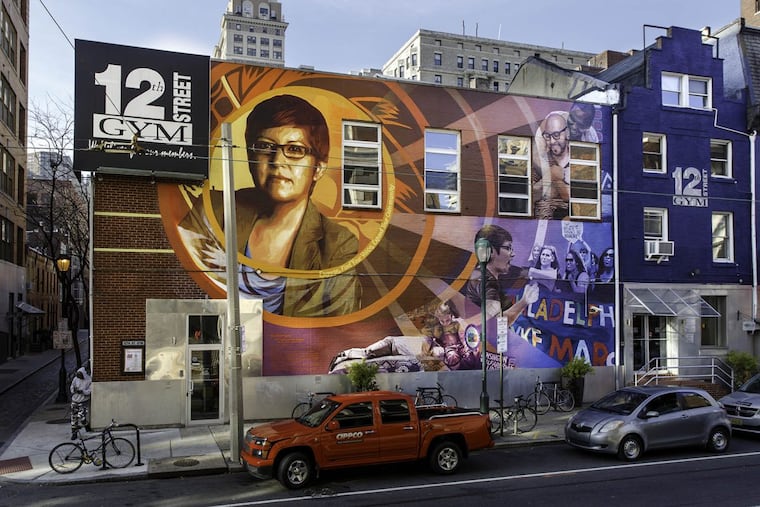12th Street Gym's mural may be in danger. The artist explains what the Gayborhood risks in losing it.
Some fear the mural of beloved LGBT activist Gloria Casarez could vanish if the gym closes and the building is demolished.

The possible closure of 12th Street Gym has stoked worry about the potential demise of its mural of Gloria Casarez, a beloved activist who served as the city's first director of LGBT affairs before she died of cancer in 2014.
"That mural means a lot to me," said Amber Hikes, who now oversees the LGBT affairs office and often demonstrated alongside Casarez in the annual Philadelphia Dyke March, which Casarez helped found. Part of the mural depicts Hikes and other activists listening as Casarez speaks into a bullhorn. "I'm beyond humbled to be able to share space with her," Hikes said.
The mural, put up in 2015, allows Casarez to watch over the Gayborhood, said photographer Kelly Burkhardt. At the Outfest block party last year, she snapped a picture as young people danced on the street at the foot of the mural.
"I just look at this picture and I see her overlooking as these kids are celebrating on the street underneath her — it's just an incredibly powerful moment," said Burkhardt, who is doing a documentary on Casarez.
The uncertainty over the mural's future stems from 12th Street Gym's financial troubles. The gym, which has been around for more than 30 years, has said it must pay at least $500,000 to address fire code violations found by the Department of Licenses and Inspections. The gym's owner, Frank Baer, is in talks this week with the owner of the building to determine whether the gym can continue to operate.
Gayborhood residents and business owners have speculated the building could be demolished — along with the Casarez mural — if the gym closes.
Philly-born artist Michelle Angela Ortiz, who created the mural, was upset to hear the mural was in danger, and emphasized its importance and what the Gayborhood risks in losing it.
You talked to Casarez's family and friends to come up with the mural's design. How is their input reflected in the mural?
In the little alleyway [facing away from 12th Street], there are these little leaves, and the leaves represent these little moments of her life. So there's an image of her grandfather. There's an image of her three aunts, who were in a sense the matriarchs of the family. These were all photos that I was able to collect from her family. There's an image of her favorite photo of herself as a child. She's 3 years old with roller skates, and then there are these stars that are behind her, because of her love for Wonder Woman.
It's a way for her family to feel connected and identify with those symbols that the public wouldn't know. And then the other images [facing 12th Street] are of her with the bullhorn and protesting.
Why was the mural placed in the Gayborhood — and why should it stay there?
It's a fairly recent mural. This mural was created in 2015. Where it's placed, on 12th Street Gym, was really strategic. In the murals that I choose to do, whether they're permanent or temporary, the intention is always to stay connected to that location.
The fact that Gloria's in the Gayborhood and she's a woman of color and she's a person that has her roots really deep within our city, it's so important for her to be there. And for others that identify with her, that's even more of a reason to have her in that location.
Why can't the mural just be taken off the gym's facade and moved somewhere else?
Part of the mural is painted directly onto the brick. The other part of the mural is painted on parachute cloth, which is a polyester fiber. You paint on top of the polyester fiber, and then it's adhered permanently with glue that's been placed on top of the brick.
The process of the parachute cloth — which a lot of the murals in Philadelphia are done this way — is that they really become part of the wall. It's as if there's another layer of paint on top of the brick. So the paint and the cloth can't be necessarily removed without removing the brick.
How were you selected to paint this mural?
I was approached by a number of her friends and family members with this idea of creating this mural in honor of her. I knew that her death was something that was a really strong hit with our community, not just in the sense of the Latino community, but just within the community of people who are activists and organizers.
Gloria, I learned through her wife, was a really big fan of my work. One of her favorite murals that I created is called the "Aquí y Allá" mural, which is located on Sixth Street between Dickinson and Tasker. It represents immigration stories of youth that have crossed the border and come to the U.S., specifically in Philadelphia. That's how I found out that she was a fan of my work.
When they approached me, it was definitely an honor. That's basically what I said to them, that I felt really honored in honoring Gloria.